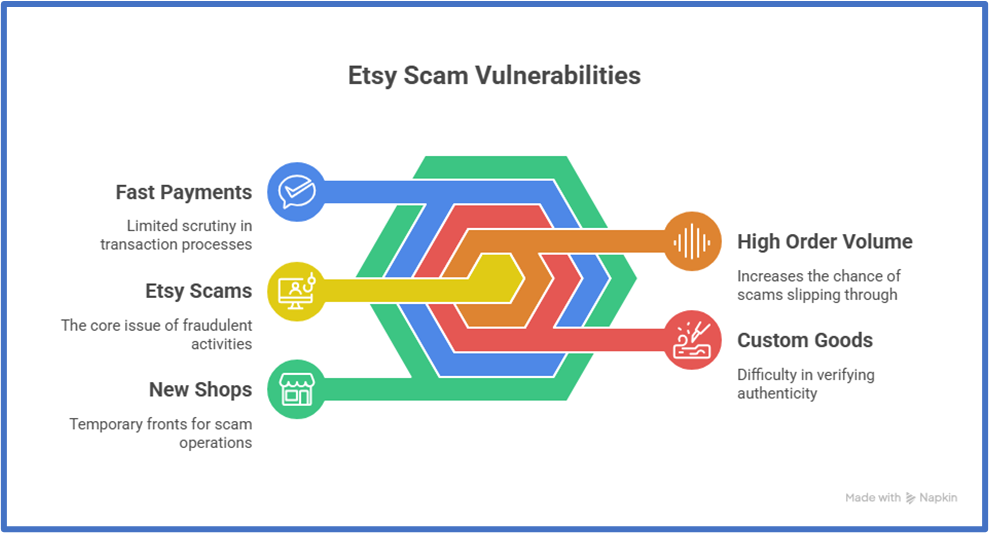Etsy is one of the most popular platforms for selling handmade and custom products. However, more and more buyers and sellers have become victims of a growing problem: Etsy scams. According to Glossy, more than 5% of products on Etsy could be replicas or infringe trademark rights, increasing the risk of fraud for users who trust the platform.
Similar alarms have grown in other markets, with phrases like “Binance is a scam” showing up in online forums and social media, reflecting how digital fraud can damage different platforms and industries. In this post, we will explain the most common Etsy scams, how to protect yourself, and what to do if you become a victim.
Need support after a scam? Join our community today.
Why Etsy Scams Target the Platform?
Etsy launched in 2005 as a marketplace for independent artisans to reach buyers worldwide, and today it connects millions seeking unique, handmade items. In 2024, it connected 95.5 million active buyers with sellers worldwide, but among them, some were scammers looking to gain trust and avoid detection, according to Capital One Shopping.
The mix of high-order volume and listings that can’t be verified before delivery creates room for abuse. Here’s why scammers focus on Etsy scams:
- Heavy daily activity lets bad actors slip past casual checks.
- Custom goods are hard to confirm without a hands-on review.
- Online payments often move fast, with limited scrutiny.
- Newly created shops can act as a temporary front.
A typical case: a new seller receives a friendly bulk offer, but the buyer insists on paying outside of Etsy. That’s a warning sign of Etsy scams, since transactions off the site aren’t covered.

Which Etsy Scams Are Most Frequently Reported?
On Etsy, fraud tactics keep changing to blend in with everyday orders. Some look so convincing that even experienced users get scammed. Here are the patterns you’re most likely to face:
1. Fake Etsy Shop Scams
This form of Etsy scams builds shops that appear legitimate to attract buyers. You’ll often see credibility signals such as high-quality product photos, detailed write-ups, and reviews imported from other accounts.
How do these scams work?
- Listings focus on rare items.
- Images are stolen from real sellers or brand catalogs.
- Prices appear too good to be true and push a quick decision.
- After payment, the seller disappears or ships a low-value item.
Why do these scams work?
- They tap into the hunt for deals and the trust people place in the marketplace.
- Short-lived profiles appear and disappear within days to avoid scrutiny.
Real-world example
A buyer ordered a “handmade” bag for $40 from a shop with polished photos and convincing descriptions. The tracking link looked legitimate, but a week later, the delivery held a generic plastic bag produced in bulk, nothing like the original listing.
2. Fake or Pirated Products
This scam targets buyers with replicas promoted as originals from well-known brands. Scammers lean on brand reputation to push low-quality pieces that look close to the real thing.
How do these scams work?
- Use brand images from official sites and catalogs.
- Copy product write-ups and specs to look legitimate.
- Set attractive prices that are still high enough to look authentic.
- After payment, send a low-value item that doesn’t match the listing.
Why do these scams work?
- A polished storefront and crisp photos can convince anyone who skips the seller’s track record.
- Many believe they’re catching a good deal or buying from an authorized reseller.
Real-world example
A shop promoted “designer” jewelry with the brand’s visuals and copy. The listings claimed sterling silver and genuine stones, priced below authorized stores yet high enough to look real.
After purchase, the buyer received pieces made with cheap alloys and imitation crystals. When they tried to secure a refund, the shop had already been removed from Etsy.
3. Bait-and-Switch Scams
Within Etsy scams, this tactic sells one item and sends something else. It can be hard to spot at first, since polished photos and professional copy are meant to win your trust.
How do these scams work?
- Listings feature sleek visuals and detailed descriptions.
- You pay expecting the item shown.
- A lower-quality product arrives, different in design, materials, or size.
- The seller cites inventory issues or a last-minute change to excuse the switch.
Why do these scams work?
- Many buyers rely on the listing and don’t anticipate a swap.
- Some professional scammers try to head off a claim with a discount or partial refund.
Real-world example
A customer bought a mouth-blown glass lamp with precise dimensions. Instead, they received a mass-produced plastic lamp. The seller claimed the “original model had sold out” and promised a “similar” replacement that never arrived.
4. Wrong Address Scams
This scam shifts the delivery address, so the buyer struggles to open a claim. Once a shipment appears as “delivered,” reversing the case becomes harder.
How do these scams work?
- Change the shipping address to a nearby, different location.
- Log the parcel as “delivered” to suggest the order was fulfilled.
- Reuse real tracking numbers that belong to unrelated shipments.
- Make it difficult for the buyer to prove the item never arrived.
Why do these scams work?
- Many protections rely on the carrier’s delivery status.
- The fraud blends into normal traffic, which slows detection.
Real-world example
A buyer purchased a décor item, but tracking showed delivery to another city 200 km away. By the time Etsy reviewed the claim, the shop had disappeared.
5. Alternate Payment Scams
This scheme pushes buyers to complete the transaction off-platform, removing buyer protection. A seller may pitch an alternative payment with promises of a discount or faster shipping, nudging you to pay outside the site.
How do these scams work?
- Reach out and suggest paying outside of Etsy.
- Ask for bank transfers, crypto, or gift cards.
- Claim fee savings or a limited-time deal.
- After payment, stop replying or block the contact.
Why do these scams work?
- Buyers expect a better price or more flexible terms.
- Without Etsy’s system, refund coverage and formal dispute channels aren’t available.
Real-world example
A buyer found a collectible and accepted a “special price” for direct PayPal payment. The funds were sent, but no item arrived. When the buyer tried to open a case, the shop was gone, and the PayPal account was closed. With no Etsy order on record, the money couldn’t be recovered.
Conversations in tech communities often raise questions like “Is Apple Intelligence a scam?”, showing that doubts about authenticity can arise in any market. To avoid falling into similar traps, Etsy users should keep all transactions within the platform’s secure framework.
Have questions about dealing with scams? Contact us for support.

6. Varying Price Scams
This branch of Etsy scams raises the price after interest or even after checkout. The seller applies pressure to collect more than agreed, leaning on the buyer’s urgency to get the item.
How do these scams work?
- List an item at a low price to prompt fast orders.
- After confirmation, claim a “pricing error” or a sudden cost jump.
- Ask for the difference or threaten to void the order.
- In some cases, the hike appears before shipping but after an upfront payment.
Why do these scams work?
- Buyers feel invested and accept the change to avoid losing the item.
- The effort required to open a claim can deter cancellations.
Real-world example
A shopper bought a contemporary print for 60 USD. Soon after, the seller said the “real price” was 120 USD and asked for the extra amount, or the order would be canceled. The buyer paid; the print never arrived, and the shop disappeared days later.
7. Phishing or Malicious Website Scams
Within Etsy scams, one of the most deceptive practices is clone phishing, where attackers create look-alike sites that replicate Etsy’s design to steal sensitive data. These replicas often imitate the platform’s layout, colors, and even product listings closely enough to trick users into sharing their credentials or payment details.
How do these scams work?
- Build webpages that mimic Etsy’s layout, logos, and color palette.
- Push links through email, social DMs, or in-platform chats.
- The user believes the site is official and types credentials or card data.
- The attacker uses the stolen details to take over the account or place unauthorized orders.
Why do these scams work?
- A close visual match can fool even experienced users.
- Urgent prompts such as “verify your account” or “order on hold” pressure for fast action.
Real-world example
A buyer received an email that seemed to be from Etsy with the subject “Problem with your last purchase.” The link led to a page that looked identical to Etsy. After entering their credentials, the account was locked within hours.
The attacker reset the password and used the access to message other users, extending the fraud.
How to Protect Yourself from Etsy Scams?
You can avoid Etsy scams by sticking to a few steady habits whenever you buy or sell. Etsy provides safeguards, and adding your routines lowers risk.
If you buy on Etsy
- Check the seller’s profile and read recent feedback before paying.
- Use Etsy-approved payment methods for every order.
- Ignore links from unexpected DMs or emails.
If you sell on Etsy
- Turn on sign-in alerts to spot unusual activity fast.
- Decline off-platform payments, even when a discount is offered.
- Keep messages and receipts inside Etsy, so any claim has a clear record.
- Turn on Two-factor authentication (2FA) to make unauthorized access far less likely.
What to Do if You’re Scammed on Etsy?
If you suspect an Etsy scam in your orders or messages, act quickly—your chances of getting a refund are much higher. The longer you wait, the lower your chances of a positive response.
Do this right away
- Open a case with Etsy Support from your account and share full details.
- Save proof like screenshots of the listing, your message thread, related emails, and any transaction records.
- Block any fake accounts tied to the incident.
- Contact your bank or PayPal to request a chargeback or start a payment dispute.
Protect Your Digital Business from Etsy Scams
Etsy scams are just one part of a much larger problem. Online fraud keeps changing, and scammers often adapt their tricks to different platforms. Cases like the Gemini scam show how quickly they can shift their approach.
At Cryptoscam Defense Network, we help you stay alert and deal with these threats. We share advice on spotting fake stores, recognizing duplicate websites, avoiding phishing, and reducing the risk of losing money. Be part of our community, share this article, and take simple steps today to protect your online business.
We Want to Hear From You!
Fraud recovery is hard, but you don’t have to do it alone. Our community is here to help you share, learn, and protect yourself from future fraud.
Why Join Us?
- Community support: Share your experiences with people who understand.
- Useful resources: Learn from our tools and guides to prevent fraud.
- Safe space: A welcoming place to share your story and receive support.
Find the help you need. Join our Facebook group or contact us directly.
Be a part of the change. Your story matters.







